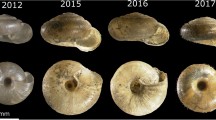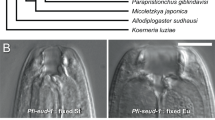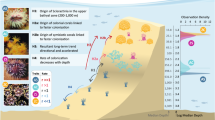Abstract
It has been suggested that the polymorphism for shell colour and pattern in Cepaea may be unrelated to the visible appearance of the shells, but maintained by heterosis or heterozygote advantage. A possible way to test this supposition is to examine whether phenotypic variance is lower in the morph exhibiting the dominant phenotype than in that with the recessive phenotype. This has been tested in two samples of shells involving totals of 1792 and 5423 individuals, respectively. Overall, there is a significantly greater variance in the recessive than the dominant class (P<0.05). Correlation between measurements on the same shell was also examined. No evidence of difference between phenotypes was found. If the difference in variance is real it may indicate either: (i) that visible appearance is not important and the polymorphism is maintained by a heterozygous balance; or (ii) evolution of such a balance in a polymorphism maintained over a long time span by selection acting on visible attributes of the shells.
Similar content being viewed by others
Article PDF
References
Beaumont, A R. 1991. Genetic studies of laboratory reared mussels, Mytilus edulis: heterozygote deficiencies, heterozygosity and growth. Biol J Linn Soc, 44, 273–285.
Brower, A V Z. 1995. Locomotor mimicry in butterflies? A critical review of the evidence. Phil Trans R Soc B, 347, 413–425.
Burke, D P T. 1979. Variation in Western Irish Populations of Cepaea nemoralis (L.). Ph.D. Thesis, University of Liverpool.
Burke, D P T. 1989. Variation in body colour in western Irish populations of Cepaea nemoralis (L.). Biol J Linn Soc, 36, 55–63.
Cain, A J. 1983. Ecology and ecogenetics of terrestrial molluscan populations. In: Russell-Hunter, W. D. (ed.) The Mollusca, vol 6, Ecology, pp. 597–647. Academic Press, New York.
Clarke, B. 1969. The evidence for apostatic selection. Heredity, 24, 347–353.
Clarke, B C, Arthur, W, Horsley, D T, and Parkin, D T. 1978. Genetic variation and natural selection in pulmonate molluscs. In: Fretter, V. and Peake, J. (eds) Pulmonates, vol. 2A, Systematics, Evolution and Ecology, pp. 219–270. Academic Press, New York.
Clarke, C A, and Sheppard, P M. 1963. Interactions between major genes and polygenes in the determination of the mimetic patterns of Papilio dardanus. Evolution, 17, 404–413.
Clarke, C A, and Sheppard, P M. 1971. Further studies on the genetics of the mimetic butterfly Papilio memnon L. Phil Trans R Soc B, 263, 35–70.
Cook, L M. 1965. Inheritance of shell size in the snail Arianta arbustorum. Evolution, 19, 86–94.
Cook, L M. 1967. The genetics of Cepaea nemoralis. Heredity, 22, 397–410.
Cook, L M. 1978. Zaire butterflies and faunal diversity in the tropics. Biol J Linn Soc, 10, 349–360.
Cook, L M, and Cain, A J. 1980. Population dynamics, shell size and morph frequency in experimental populations of the snail Cepaea nemoralis (L.). Biol J Linn Soc, 14, 259–292.
Crow, J F. 1986. Basic Concepts in Population, Quantitative, and Evolutionary Genetics. Freeman, New York.
Davies, R G. 1971. Computer Programming in Quantitative Biology. Academic Press, London.
Dobzhansky, TH, and Levene, H. 1951. Development of heterosis through natural selection in experimental populations of Drosophila pseudoobscura. Am Nat, 85, 247–264.
Dobzhansky, TH, and Levene, H. 1955. Genetics of natural populations. XXIV. Developmental homeostasis in natural populations of Drosophila pseudoobscura. Genetics, 40, 797–808.
Dobzhansky, TH, and Wallace, B. 1953. The genetics of homeostasis in Drosophila. Proc Nat Acad Sci Wash, 39, 162–171.
Edmunds, M. 1969. Polymorphism in the mimetic butterfly Hypolimnas misippus L. in Ghana. Heredity, 24, 281–302.
Endler, J A. 1988. Frequency-dependent predation, crypsis and aposematic coloration. Phil Trans R Soc B, 319, 505–523.
Foote, M, and Cowi, R H. 1988. Developmental buffering as a mechanism for stasis: evidence from the pulmonate Theba pisana. Evolution, 42, 396–399.
Goodhart, C B. 1987. Why are some snails visibly polymorphic, and others not? Biol J Linn Soc, 31, 35–58.
Hotelling, H. 1953. New light on the correlation coefficient and its transforms. J R Statist Soc B, 15, 193–232.
Jones, J S. 1982. Genetic differences in individual behaviour associated with shell polymorphism in the snail Cepaea nemoralis. Nature, 298, 749–750.
Jones, J S, Leith, B H, and Rawlings, R. 1977. Polymorphism in Cepaea: a problem with too many solutions? Ann Rev Ecol Syst, 8, 109–143.
Koehn, R K, Diehl, W J, and Scott, T M. 1988. The differential contribution of individual enzymes of glycolysis and protein catabolism to the relationship between heterozygosity and growth rate in the coot clam, Mulinia lateralis. Genetics, 118, 121–130.
Maynard Smith, J. 1989. Evolutionary Genetics. Oxford University Press, Oxford.
Mitton, J B, and Grant, M C. 1984. Associations among protein heterozygosity, growth rate, and developmental homeostasis. Ann Rev Ecol Syst, 15, 479–499.
Palmer, A R, and Strobeck, C. 1986. Fluctuating asymmetry: measurement, analysis, patterns. Ann Rev Ecol Syst, 17, 391–421.
Sheppard, P M. 1975. Natural Selection and Heredity, 4th edn. Hutchinson, London.
Smith, D A S. 1976. Phenotypic diversity, mimicry and natural selection in the African butterfly Hypolimnas misippus L. (Lepidoptera: Nymphalidae). Biol J Linn Soc, 8, 183–204.
Sokal, R R, and Rohlf, F J. 1969. Biometry The Principles and Practice of Statistics in Biological Research. Freeman, San Francisco.
Turner, J R G. 1977. Butterfly mimicry: the genetical evolution of an adaptation. Evol Biol, 10, 163–206.
Van Valen, L. 1974. Multivariate structural statistics in natural history. J Theor Biol, 45, 235–247.
Vane-Wright, R L, Ackery, P R, and Smiles, R L. 1977. The polymorphism, mimicry, and host plant relationships of Hypolimnas butterflies. Biol J Linn Soc, 9 285–297.
Yezerinac, S M, Lougheed, S C, and Handford, P. 1992. Morphological variability and enzyme heterozygosity: individual and population level correlations. Evolution, 46, 1959–1964.
Zouros, E. 1987. On the relation between heterozygosity and heterosis: an evaluation of the evidence from marine mollusks. Isozymes: Curr Top Biol Med Res, 15, 255–270.
Zouros, E, and Foltz, D W. 1987. The use of allelic isozyme variation for the study of heterosis. Isozymes: Curr Top Biol Med Res, 13, 1–59.
Acknowledgements
We thank G. S. Mani for providing the method for obtaining probability of F and A. J. Cain for helpful comments on the paper and methodology.
Author information
Authors and Affiliations
Rights and permissions
About this article
Cite this article
Cook, L., Gao, G. Test of association of morphological variation with heterozygosity in the snail Cepaea nemoralis. Heredity 76, 118–123 (1996). https://doi.org/10.1038/hdy.1996.18
Received:
Issue date:
DOI: https://doi.org/10.1038/hdy.1996.18



